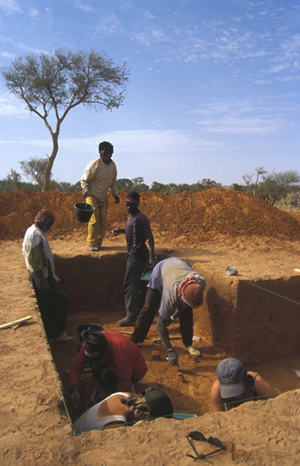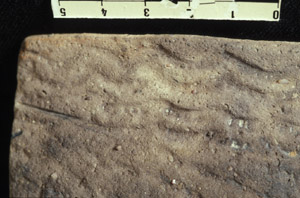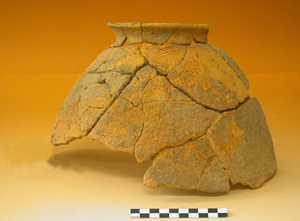The Late Neolithic/Later Stone Age of Ounjougou corresponds to the 2600-400 cal BC period, which is divided into three major settlement phases (Phases 4, 5 and 6 of the Holocene of Ounjougou). This period was marked by the important climatic and environmental changes that affected West Africa during the late Holocene, as well as several major cultural transitions and the development of agriculture around 1800 cal BC
The research strategy developed for understanding the Late Neolithic of Dogon country took place in two distinct steps. Initially, a chrono-cultural reference sequence for the Bandiagara plateau, whose prehistory remained unknown until the early 1990’s, was developed using data from the site complex of Ounjougou. The second part of the process consisted of a geographical extension of the fieldwork to verify the relevance of the Ounjougou sequence, and to understand the gaps highlighted in the Yamé Valley. The research has been therefore gradually extended to the Bandiagara cliff and the Séno plain. Punctual surveys also allowed collecting information on the western Bandiagara Plateau and in the south-eastern Séno plain.
Late Neolithic I (2600-2200 cal BC)
Corresponding to Phase 4 of the Holocene of Ounjougou, the Late Neolithic I takes place in a context of gradual desiccation of the landscapes, which is associated with the movement of vegetation zones to the south following a significant reduction in rainfall at the beginning of Late Holocene in West Africa. Vegetation landscapes of the plateau gradually shift to a mosaic savannah / open forest. The characteristics of the Late Neolithic pottery I are very original, with a high proportion of sponge spicules in the paste, quartz being the most commonly used temper. We note the presence of wide open potteries with covering roulette decoration, in one case associated with a “Dotted wavy line” pattern decoration.
No evidence of herding is associated with this phase so far. It must be emphasized here that the nature of the sediments encountered at Ounjougou does not allow conservation of bones, even in the short term. However, the region may have been occasionally occupied at this time by pastoralists from the southern fringe of the Sahara during their transhumance. Agriculture is not yet practiced.
Late Neolithic II (1800-800 cal BC)
Late Neolithic II corresponds to phases 5a and 5b of the Holocene of Ounjougou. It is characterized by a well-marked metamorphosis of landscapes and functioning of the Yamé Valley watershed, reflecting enhanced seasonality. A savannah environment with Sahelo-Sudanian affinities develops and is crossed annually by bushfires, while a radically different economic and cultural context takes place in the Yamé Valley. The cultivation of pearl millet (Pennisetum glaucum) is practiced in the region from 1800 cal BC. Stone structures remains indicate the presence of seasonal establishments on the Yamé shores from 1800 cal BC, and villages or cultivation hamlets then develop on the edges of the valley between 1300 and 800 cal BC.
Ceramic traditions show a break with the former Late Neolithic I period. We especially note the appearance of globular and narrowed opening vessels. The decorations made by multiple-frame roulette impressions are very common, and we also note the emergence of incised arcs patterns. One notes also the beginning of red paint use, especially applied to the neck of vessels. A sparse lithic industry on quartz or quartzite is also associated with the Late Neolithic II, including flakes and nucleus that reveal the practice of bipolar reduction on anvil, as well as some quartz scrapers and borers.
The presence of polished stone axes is also demonstrated. Their size is generally small and some marks of use on their heel and edge suggest that they were maybe used as intermediate tools, perhaps for woodworking.
The end of Late Neolithic in Dogon country (800-400 cal BC)
On the Bandiagara plateau, the early 1st mill. cal BC is witnessing more arid climatic conditions than those prevailing during the Late Neolithic II. Landscapes include now Sudano-Sahelian species. During the dry season, which is now longer than before, the ponds of the Yamé Valley are completely dried out, and anthropogenic bushfires are important. On the Bandiagara plateau and near the cliff, potteries still show impressed roulette decorations, although probably made with coarser tools. The archaeological remains attributed to this period, however, are far less frequent. The phase 6 of Ounjougou corresponds thus likely to the last phase of Neolithic occupation of the plateau. During the same time interval, the Bandiagara escarpment and the Séno plain, are however faced with the establishment of a transitional Neolithic-Iron Age period, whose ceramic traditions reflect both a Late Neolithic II substrate and the arrival of fully new influences.




